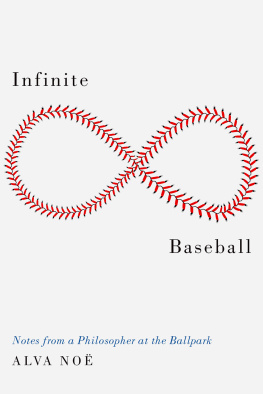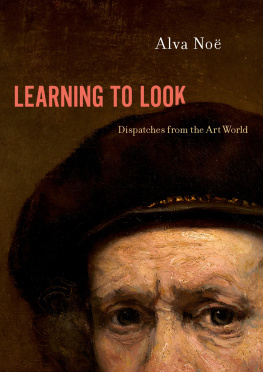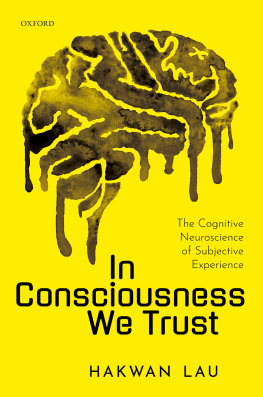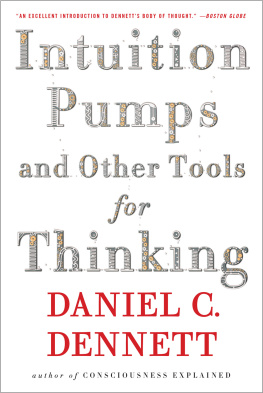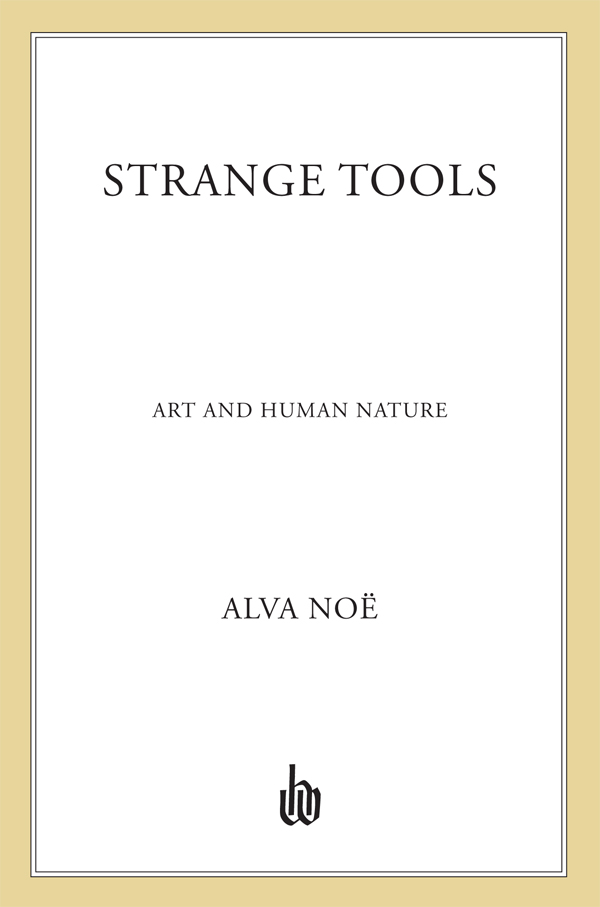Contents
Guide

The author and publisher have provided this e-book to you for your personal use only. You may not make this e-book publicly available in any way. Copyright infringement is against the law. If you believe the copy of this e-book you are reading infringes on the authors copyright, please notify the publisher at: us.macmillanusa.com/piracy.
For Hans No and Judith Baldwin No
By one of the ironic perversities that often attend the course of affairs, the existence of the works of art upon which formation of an esthetic theory depends has become an obstruction to theory about them.
John Dewey
Some years ago I was talking with an artist. He asked me about the science of visual perception. I explained that vision scientists seek to understand how it is we see so muchthe colorful and detailed world of objects spread out around us in spacewhen what we are given are tiny distorted upside-down images in the eyes. How do we see so much on the basis of so little?
I was startled by the artists reply. Nonsense! he scoffed. Thats not the question we should ask. The important question is this: Why are we so blind, why do we see so little, when there is so much around us to see?
This exchange took place when I was a graduate student. The artists remark stayed with me. It brings out sharply the opposition between two different ways of thinking about visual experience.
In one way, the scientists way, seeing happens in the brain, thanks to the way the brain manages to make sense of information available on the retina.
In the other way, the artists way, seeing isnt something that happens automatically, or for free; we are too liable not to see even what is there. Seeing is an achievement, our achievement, the achievement of making contact with what there is. We can fail to see.
I have spent the last two decades studying perception and perceptual consciousness. I have sought to develop a new way of understanding perception. Seeing, according to the enactive or actionist position that I have been working out, is not something that happens in our brains, or anywhere else, for that matter; it is something we do, or make, or achieve. And like everything else we achieve, we do so only against the background of our skills, knowledge, situation, and environment, including our social environment.
It dawned on me only recently that my research these last years has aimed at vindicating precisely the perspective of the artist in my anecdote. He had it right all along. The brain is necessary for experience, to be sure. But it is not the whole story. The scientists conception is impoverished, and it gets in the way of our appreciating that it is not brains that perceive, but active animals or people. Seeing, I have come to realize, and so Ive been urging in my writing, is more like climbing a tree, or reading a book, than it is like digesting what youve eaten.
But this anecdote suggests something more. The artist was right. Science and philosophy, to the extent that they concern themselves with art, tend to do so from on high. They seek to explain art, to treat art as a phenomenon to be analyzed. Maybe weve been overlooking the possibility that art can be our teacher, or at least our collaborator. Not because art is cryptoscience, but because it is its own manner of investigation and its own legitimate source of knowledge. This is what is suggested to me as I think back on this conversation with the artist.
This is a puzzling if attractive possibility. Its attractive, for it offers, right off the bat, some clue to why art is so important. But its puzzling, too, because art looks very different from science, which is explicitly concerned with the production of knowledge and understanding. What might the character of the knowledge at which art aims be?
Heres part of the answer: art provides us an opportunity to catch ourselves in the act of achieving our conscious lives, of bringing the world into focus for perceptual (and other forms of) consciousness. And so art is a field in which we can take seriously the artists question posed above: not, how do we manage to see so much? but rather, why do we see so little? Even as it also gives us an opportunity to move from not seeing to seeing, or from seeing to seeing more or seeing differently.
* * *
This book is animated by three ideas.
First, art is not a technological practice; however, it presupposes such practices. Works of art are strange tools. Technology is not just something we use or apply to achieve a goal, although this is right as a first approximation. Technologies organize our lives in ways that make it impossible to conceive of our lives in their absence; they make us what we are. Art, really, is an engagement with the ways our practices, techniques, and technologies organize us, and it is, finally, a way to understand our organization and, inevitably, to reorganize ourselves.
The job of art, its true work, is philosophical. This is the second animating idea. Art is a philosophical practice. And philosophyartists will like this, Im not so sure about philosophersis an artistic practice. This is because both art and philosophysuperficially so differentare really species of a common genus whose preoccupation is with the ways we are organized and with the possibility of reorganizing ourselves. I dont mean that this is what artists think or say they are doing (although some will). I mean that this is what they are and have always been doing. And this is what philosophy does.
The third and final animating idea is one that will itself acquire meaning only after we have advanced considerably: art and philosophy are practices, as I put it, bent on the invention of writing.
To be part of something one doesnt in the least understand is, I think, one of the most intriguing things about life.
Agatha Christie
Western art abounds with depictions of the nursing mother. The display of the Mother and Child is central to Christian religious thinking, so this isnt surprising. But it may be that pictures of the suckling infant are important to us for reasons that go beyond our interest in the life of Jesus. Breast-feeding, after all, is basic to our mammalian biology; it is also, for the vast majority of us, our first opportunity for nurturing love. In fact, or so at least I propose, breast-feeding is also a key to understanding the very nature of art; the fact that pictures of nursing mothers are so common may point to one of arts abiding features: art is always concerned with itself.
The connection between breast-feeding and the nature of art is not immediately apparent. This may just show how far we need to go to get a clear understanding of art and its origins in our biology.
When it comes to breast-feeding, the striking thing about human beings is that, alone among the mammals, we do it very badly. Its not just that breast-feeding can be difficult for usmany babies need to learn to latch on, and this can get stressful for both mother and child as the need for food is urgent and dramatic. Our frailty as feeders is more far-reaching than that. With all other mammals, once the infant has latched on, it stays put and sucks until the job is done, until it is sated, or until some external factor (a competitive sibling, for example) drives it away.
But not so the human baby. Our babies are liable to wander during the task. They get distracted by noises. Or they blissfully fall asleep. Or they indulge in the pleasures of biting and chewing to the neglect of the main business at hand, which is drinking . Isnt it? Actually, so inefficient is human breast-feeding that some anthropologists and psychologists have speculated that its primary evolutionary value in humans may not consist in feeding at all, but may lie elsewhere. Perhaps weve got it backward. We dont suckle to feed; we feed at the breast, so that we can touch and hold and embrace. Physical contact induces neurochemical events (such as the release of oxytocin) that are beneficial and necessary. And then there is the fact, perhaps not unrelated to the neurochemistry, that physical contact cements the attachment of mother and infant.


